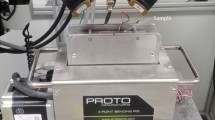Abstract
A combined Moiré-Sagnac interferometry method is developed for in-plane (u andv) and out-of-plane (w) surface deformation measurement. The combined optical setup is used to measure three-dimensional crack tip deformations of AI 2024-0 and AI 2024-T4 specimens at room temperature and an inconel 909 specimen at 570°C. Measured displacements near the crack tip region of the AI 2024-T4 specimen are used as input nodal displacements to determine stress intensity factors based on two-dimensional and three-dimensional Jacobian derivative method. The values compare favorably with theoretical calculations. The extent of the three-dimensional crack tip deformation zone is also discussed.
Similar content being viewed by others
References
Kang, B.S.J., Zhang, G.Z., Jenkins, M.G., Ferber, M., and Ifju, P., “Development of Moire-interferometry for In-situ Material Surface Deformation Measurement at High Temperature,” SEM Spring Conference on Experimental Mechanics, Dearborn, Michigan, 964–976 (1993).
Wang, F.X., Ifju, P., and Kang, B.S.-J., “High-temperature Moire Interferometry Using Zero-thickness Grating,” SEM Spring Conference on Experimental Mechanics, Las Vegas, Nevada, 727–731 (1992).
Kang, B.S.-J., Yao, Q., Li, Z., andLiu, C.T., “Investigation on Environmental Assisted Fracture Behavior of Iron Aluminides Using Moire Interferometry,”Mat. Sci. Eng.,A239–240,344–352 (1997).
Carpenter, W., Kang, B.S.-J., and Chang, K.M., “SAGBO Mechanism on High Temperature Cracking Behavior of Ni-base Superalloys,” TMS International Symposium on Superalloys, 718, 625, 706 and Various Derivatives, Pittsburgh, Pennsylvania, 679–688 (1997).
Wang, F.X. and Kang, B.S.-J., “Moire Interferometry in Liquid Mediums,” SEM, Proceedings of the VII International Congress on Experimental Mechanics, Las Vegas, Nevada, 1711–1766 (1992).
Vest, C.M., “Coherent Optics, Holography, and Holographic Interferometry,”in Holographic Interferometry, John Wiley & Sons, New York, 1–66 (1979).
Hecht, E. andZajac, A., Optics, Addison-Wesley, Reading, MA (1974).
Post, D., Han, B., andIfju, P., High Sensitivity Moire, Springer-Verlag, New York (1994).
Asundi, A., Cheung, M.T., andLee, C.S., “Moire Interferometry for Simultaneous Measurement of u, v, w,” EXPERIMENTAL MECHANICS,29,258–260 (1989).
Daniel, I.M., “Experimental Methods in Applied Mechanics,”J. Appl. Mech.,50,973–976 (1983).
Barbero, E.J. andReddy, J.N., “The Jacobian Derivative Method for Three-dimensional Fracture Mechanics,”Communications Appl. Numer. Meth.,6,507–518 (1990).
Edward, H.L. and Wanhill, R.J.H., “Crack-tip Plasticity,” in Fracture Mechanics, Edward Arnold, 56–71 (1984).
Hahn, G.T. andRosenfield, A.R., “Local Yielding and Extension of a Crack Under Plane Stress,”Acta Metall.,13,293–306 (1965).
Yang, W. andFreund, L.G., “Transverse Shear Effects for Throughcracks in an Elastic Plate,”Int. J. Solids Struct.,21,977–994 (1985).
Nakamura, T. andParks, D.M., “Three-dimensional Stress Field near the Crack Front of Thin Elastic Plate,”J. Appl. Mech.,55,805–813 (1988).
Rosakis, A.J. andRavi-Chandar, K., “On Crack-tip Stress State: An Experimental Evaluation of Three-dimensional Effects,”Int. J. Solids Struct.,22,121–134 (1986).
Sagnac, G., “L'ether lumineux demontre par l'effect du vent relatif dether dans un interferometre en rotation uniforme,”Acadamie der Science, Paris Comptes Randus,157,708–710 (1913).
Eichmann, G., Li, Y., andAlfano, R.R., “Digital Optical Logic Using a Pulsed Sagnac Interferometer Switch,”Opt. Eng.,25,91–97 (1986).
Huang, A., “Sagnac Fiber Logic Gates and Their Possible Applications: A System Perspective,”Appl. Opt.,33,6254–6266 (1994).
Post, D., “Moire Interferometry,”in Handbook on Experimental Mechanics, 2d ed., A.S. Kobayashi ed., Society for Experimental Mechanics, Bethel, CT, 297–364 (1993).
Wang, F.X., Kang, B.S.-J., and Lin, K.Y., “Full-field Displacements by Four-beam Moire Interferometry,” SEM Spring Conference on Experimental Mechanics, Milwaukee, Wisconsin, 278–284 (1991).
Hertzberg, R.W., Elements of Fracture Mechanics, John Wiley & Sons, New York (1989).
Hellen, T.K., “On the Method of Virtual Crack Extension,”Int. J. Numer. Meth. Eng.,9,187–207 (1975).
Parks, D.M., “A Stiffness Derivative Finite Element Technique for Determination of Elastic Crack-tip Stress Intensity Factors,”Int. J. Fract.,10,487–502 (1974).
Barbero, E.J., “Computer Code for 2-D and 3-D Jacobian Derivative Method,”CFC report, West Virginia University, Morgantown (1995).
Tada, H., Paris, P.C., andIrwin, G.R, The Stress Analysis of Cracks—Handbook, Paris Production, Inc., St. Louis, MO (1985).
Author information
Authors and Affiliations
Rights and permissions
About this article
Cite this article
Kang, B.SJ., Anderson, S.M. Three-dimensional crack tip deformation measurement using combined Moiré-Sagnac interferometry. Experimental Mechanics 41, 84–91 (2001). https://doi.org/10.1007/BF02323109
Received:
Revised:
Issue Date:
DOI: https://doi.org/10.1007/BF02323109




